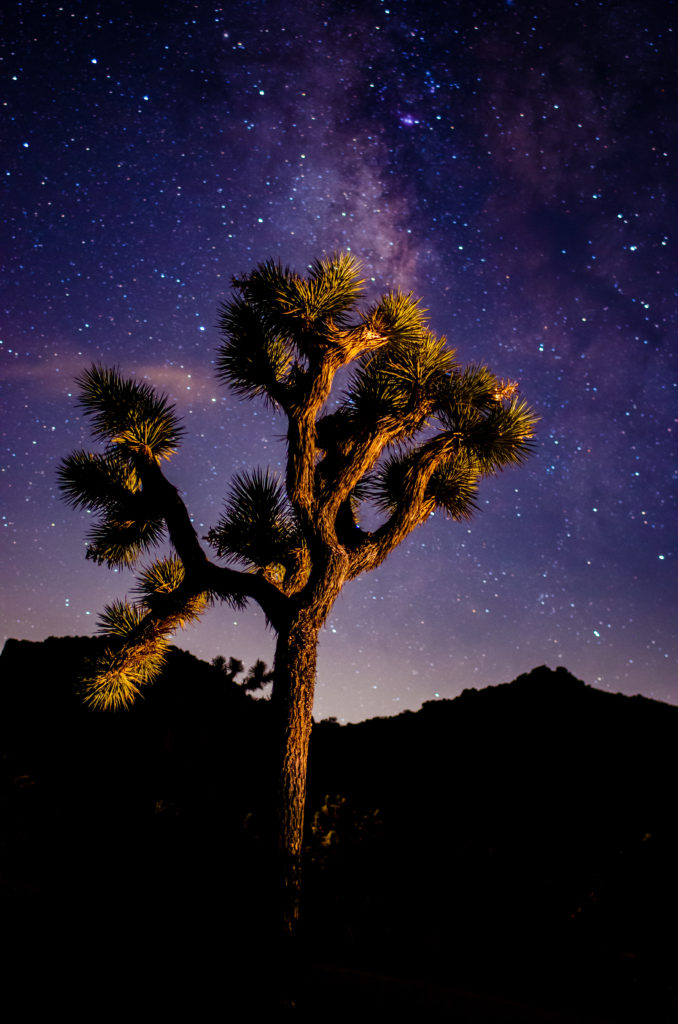Joshua Tree National Park is an incredibly awe inspiring natural wonder located within the Mojave and Colorado deserts. It’s named for the rare Joshua tree that grows in the area, but it’s distinct night sky views will make you forget about any trees and take you to another world. With nearly uninterrupted views, far away from city lights, visitors are left to experience a vivid view of the night sky like never before. Read on to learn more about experiencing the breathtaking sights of the night sky at Joshua Tree National Park.
Stargazing at Joshua Tree National Park
Joshua Tree is home to some of the best stargazing opportunities in Southern California, making it one of the top dark sky parks in North America. The unspoiled location makes for unmatched views of galaxies, constellations, comets, stars, planets and other celestial bodies. On a clear night or early morning, hikers can see millions of stars dotting the night sky as if they are suspended right over their heads – it really is a sight to behold!
Tips for Stargazing at Joshua Tree
- Choose a clear night, with the sky away from any sources of light pollution.
- Bring a pair of binoculars and a telescope (if you have one).
- Check the moon phase and timing, depending on your preferences.
- Dress in layers, since Joshua Tree can get quite chilly at night even during the summer months.
- Take some snacks or drinks if desired—but leave no trace!
- Familiarize yourself with Star maps/constellations (apps available for download)
- Arrive early and ensure you are ready to spot stars while it is still dark outside
- Make sure you find the Milky Way Galaxy, since this cosmic beauty offers spectacular views in Joshua Tree’s dark starry skies!
Popular Programs & Special Events
In addition to just simply observing stars while visiting Joshua Tree National Park, there are also a variety of organized opportunities available year-round such as astronomy classes and lectures led by qualified professionals who can point out specific sights or provide background information on what is visible in that season. Occasionally there are special events including stargazing programs accompanied by telescope viewing sessions where groups gather around large telescopes ready with trained guides waiting to answer questions about what it is everyone is looking at; these sorts of activities help beginners learn how astronomy works and how to identify constellations easily in future excursions.
Campsites & Lodging
If you want an extra special opportunity for night sky viewing during your trip then look no further than setting up camp (either primitive or established) within Joshua Tree National Park for overnight stays – this ensures having access not only during evening hours when most star gazing activities occur but also throughout sunrise so you can watch and follow how shadows move across earthy landforms which create even more dramatic vistas during dawn hours. There are numerous campgrounds located inside park boundaries offering places to stay connected directly with nature while you star gaze all throughout the night without having to worry about lights from nearby cities’ interfering views.
With its unique desert landscapes and unobstructed sight-lines right into space beyond our atmosphere there definitely isn’t anything quite like experiencing a vivid star show courtesy Joshua Tree National Park which itself remains untouched world-class natural wonder worth exploring whenever possible regardless time day or night – don’t miss bringing supplies enjoy fascinating exposed truths universe between sand dunes while catching few zzzs’ under brilliant constellation patterns regularly seen from dark skies above here!
Joshua Tree FAQs
A: Joshua Tree National Park is located about 140 miles east of Los Angeles and 30 miles north of Palm Springs. The nearest airports are Palm Springs International Airport and Ontario International Airport. From there, you can rent a car or take a shuttle service to the park.
A: The best time to visit Joshua Tree National Park is during the cooler months, typically from October to May. Summers can be scorching, with temperatures exceeding 100 degrees Fahrenheit.
A: You should bring plenty of water, sunscreen, and appropriate clothing for the desert climate. Hiking shoes or boots are recommended for exploring the park’s trails. You may also want to bring a hat, sunglasses, and a map or guidebook.
A: It’s important to stay hydrated and avoid overexertion in the desert heat. Be sure to stick to designated trails and stay aware of your surroundings, including any wildlife. You should also be prepared for sudden weather changes, including flash floods and high winds.
